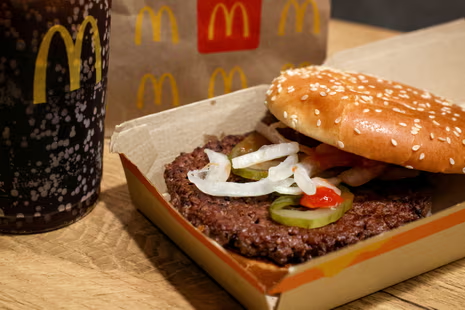A recent E. coli outbreak linked to McDonald’s products has raised serious public health concerns, with one person tragically losing their life and 49 others falling ill across several states in the U.S. Officials, including the Centers for Disease Control and Prevention (CDC), have issued an urgent warning as the fast-food chain takes swift action to address the crisis.
The outbreak has been tied to specific ingredients in McDonald’s Quarter Pounder menu item, prompting the temporary removal of both Quarter Pounders and slivered onions from impacted stores. This article breaks down the situation, its implications, and what you need to know to stay safe.

Some strains of E. coli can cause serious illness (STEVE GSCHMEISSNER/SCIENCE PHOTO LIBRARY/Getty Images)
Understanding the E. Coli Outbreak
What Is E. Coli and Why Is It Dangerous?
Escherichia coli (E. coli) is a type of bacteria commonly found in the intestines of humans and animals. While most strains are harmless, certain types, like Shiga toxin-producing E. coli (STEC), can cause severe illness. According to the World Health Organization (WHO), STEC infections are responsible for “severe foodborne illness” that can lead to serious complications, including kidney failure.
Symptoms of an STEC infection typically include:
- Severe stomach cramps
- Bloody diarrhea
- Vomiting
The CDC notes that symptoms usually appear 3 to 4 days after consuming contaminated food or water and can last 5 to 7 days. Most individuals recover without medical intervention, but in some cases, serious complications like hemolytic uremic syndrome (HUS) may develop, requiring hospitalization.
What We Know About the McDonald’s Outbreak
Confirmed Cases and Impacted Areas
The CDC has confirmed 49 cases of E. coli across multiple states, with 10 hospitalizations and one reported fatality. The outbreak has primarily affected regions in the western and central United States, including:
- Colorado
- Kansas
- Utah
- Wyoming
- Portions of Idaho, Iowa, Missouri, Montana, Nebraska, Nevada, New Mexico, and Oklahoma
Suspected Source: Slivered Onions
Initial findings indicate that slivered onions used in McDonald’s Quarter Pounders are the likely source of contamination. These onions, sourced from a single supplier servicing three distribution centers, have been removed from all affected locations as a precautionary measure.
McDonald’s Response to the Crisis
Swift Action to Protect Customers
Cesar Piña, McDonald’s North America Chief Supply Chain Officer, emphasized the company’s commitment to customer safety. “It is why we are taking swift and decisive action following an E. coli outbreak in certain states,” he stated.

The following steps have been implemented:
- Removal of Slivered Onions: All restaurants in affected areas have been instructed to remove slivered onions from their inventory.
- Pause on Quarter Pounder Sales: Quarter Pounders have been temporarily discontinued in impacted states.
- Menu Adjustments: Other menu items, including Big Macs, Cheeseburgers, and Double Cheeseburgers, remain unaffected and are still available.
Replenishing Supply and Ensuring Safety
McDonald’s is working closely with its suppliers and the CDC to investigate the outbreak and prevent further cases. The company has assured customers that unaffected menu items remain safe to consume and is actively working to replenish Quarter Pounder supplies with ingredients from alternative sources.
What You Should Do if You’re Affected
Recognizing Symptoms

The CDC urges individuals to seek medical attention if they experience any of the following:
- Diarrhea lasting more than three days
- Bloody diarrhea
- A fever higher than 102°F
- Severe vomiting that prevents keeping liquids down
- Signs of dehydration, such as dry mouth, dizziness, or infrequent urination
When to Contact a Healthcare Provider
Early intervention is crucial if symptoms worsen or if signs of kidney complications, such as hemolytic uremic syndrome (HUS), develop. Symptoms of HUS include extreme fatigue, reduced urination, and skin pallor.
How to Stay Safe During an Outbreak
Be Cautious with Food Preparation
Foodborne illnesses like E. coli often stem from contaminated ingredients or improper handling. To reduce your risk:
- Wash hands, utensils, and surfaces thoroughly after handling raw food.
- Cook meat to a safe internal temperature (160°F for ground beef).
- Avoid cross-contamination between raw and cooked foods.
Monitor Official Updates
Stay informed by following updates from the CDC and other health authorities. Regular announcements provide critical information about the status of the outbreak and any additional safety measures.
McDonald’s Commitment to Transparency and Safety

Communication with Customers
McDonald’s has pledged to provide timely updates as the investigation continues. Their swift action highlights the company’s dedication to addressing the situation responsibly while maintaining transparency with customers.
A Focus on Long-Term Safety
As McDonald’s works to resolve the issue, the company is also reviewing its supply chain protocols to prevent similar incidents in the future. This includes strengthening safety measures for ingredient sourcing and distribution.
Conclusion: A Reminder of the Importance of Food Safety
The recent E. coli outbreak linked to McDonald’s products serves as a sobering reminder of the importance of food safety at every stage of the supply chain. While the fast-food giant’s prompt response demonstrates its commitment to protecting customers, the incident underscores the need for vigilance in preventing foodborne illnesses.
As investigations continue, it’s vital for consumers to stay informed, recognize symptoms, and take precautions to safeguard their health. In the meantime, McDonald’s and health authorities are working tirelessly to restore safety and confidence in their products.
This outbreak may leave a mark on public perception, but it also offers an opportunity for stronger safety protocols and a renewed commitment to the well-being of customers.


